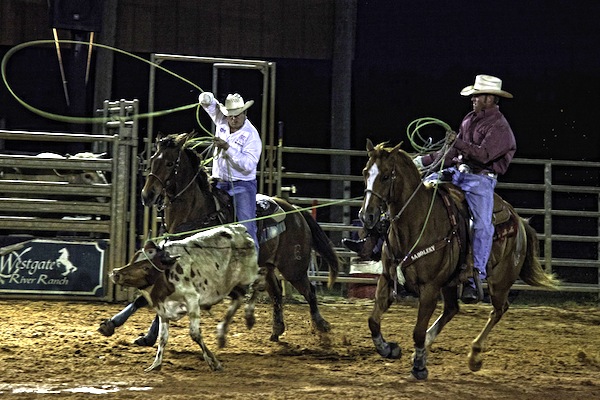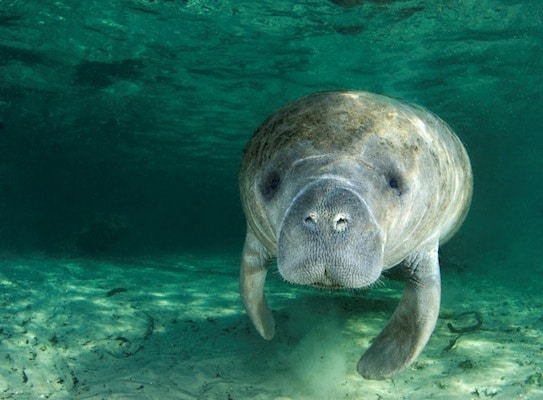Before Mickey, Minnie, Donald and Goofy arrived, Florida’s cast of characters included manatees, alligators, reptiles, herons, egrets and the elusive Florida panther. They’re all still around, along with many other interesting species. Here are seven great places to introduce your family to Florida’s original characters … the wildlife.
Blue Springs and DeLeon Springs
About an hour east of Orlando, Blue Springs State Park, the largest spring on the St. Johns River, is a designated manatee refuge. Imagine a place where you and the kids can stroll a boardwalk and watch manatees feed and care for their calves. This is the place. An estimated 250 to 300 manatees dwell in this area of the St. Johns River. From November through March when the river’s temperatures drop, many of the manatees seek out the consistently warmer waters in Blue Springs for their winter home. And during the summer, families flock to Blue Springs to swim, canoe, kayak, snorkel or take a riverboat tour.
According to legend, Juan Ponce de Leon discovered the mythical Fountain of Youth in the area now known as DeLeon Springs, just 15 miles north of Blue Springs on U.S. 17. It’s a place rich in history. Indian canoes dating back 5,000 to 6,000 years were found in the spring and represent some of the oldest in America. Spanish moss hangs from the trees, providing a canopy of shade for the picnic areas. Today, the smell of fired-up grills permeates the air and children run between the picnic pavilions, the spring pool and the playground. Herons, egrets and ducks wade in the waters nearby.
For a sweet treat, make your own pancakes at the Old Spanish Mill Grill & Griddle House. Pitchers of batter and a griddle await at each table along with your favorite toppings, including pecans, blueberries, bananas, chocolate chips and apples.
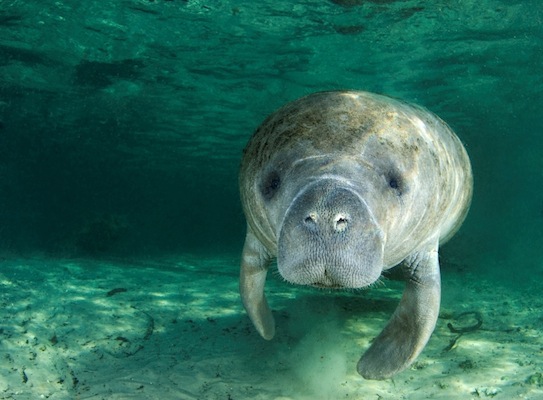
Everglades National Park
At 2,200 square miles, the Florida Everglades is the largest sub-tropical wilderness in the continental U.S. The landscape is a vast expanse of sawgrass, lakes, sloughs, mangrove forests and trees rising above the marsh called hammocks.
The Everglades is home to more than 1,000 species of fish, birds, reptiles, amphibians and mammals, including the endangered Florida panther. This is the only place in the world where you can find both alligators and crocodiles. Don’t miss the Observation Tower at Shark Valley where you can see for miles around and observe the wildlife in the park’s swampy habitat.
Rent bikes and take the Shark Valley Loop, a flat, easy trail that provides the best chance of seeing alligators. For an up-close-and-personal experience with the swamp creatures, take a canoeing or kayaking trip along some of the 99 miles of marked waterways between Everglades City and Flamingo. Don’t forget to pick up a Junior Ranger book for the kids at one of the visitor centers.

Gatorland
Old style Florida entertainment has been the theme at Orlando’s Gatorland since its opening in 1949. Enter through a giant alligator’s mouth to see snakes, lizards, Florida deer and spiders before heading to Alligator Island – home to hundreds of alligators and even a few crocodiles.
The Gatorland Express train delivers you to the Gator Wrestlin’ Arena, where real live cowboys wrestle the snapping gators and climb onto their backs.Think you can conquer a gator? Step in the sandbox in the Gator Wrestlin’ Arena and give it a shot with the “Rookie Wrestlin’” experience.
If watching and wrestling gators isn’t enough, venture into the Alligator Breeding Marsh for an unforgettable behind-the-scenes tour. Stand within a few feet of huge, hungry alligators and watch their feeding frenzy. Your guide will make sure your family isn’t on the dinner menu.
The Screamin’ Gator Zip Line soars through the air over some of the theme park’s star attractions – including Cuban and Nile crocodiles – before heading over the Alligator Breeding Marsh, where 130 giant alligators are watching from below.
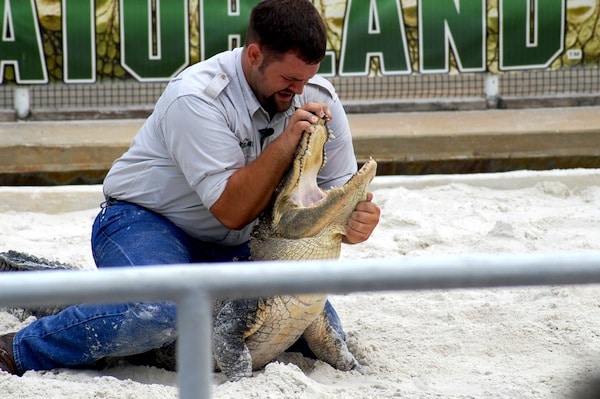
Homosassa Springs Wildlife State Park
Situated a few miles from the Gulf of Mexico in Citrus County, Homosassa Springs Wildlife State Park serves as a rehabilitation and refuge center for injured West Indian manatees. The park’s Fishbowl, a floating underwater observatory, is the only place in the world where you can view manatees underwater in their natural habitat without getting wet. Watch through the large plate glass windows as these gentle giants glide by alongside thousands of fish.
A boat transports you from the visitor center to the park entrance while park rangers identify the wildlife along the way.Twice daily, one of the park rangers or a Wildlife Care Volunteer introduces an example of a native Florida species at the Wildlife Encounter Pavilion. The species may be a bird of prey, an opossum, a gopher tortoise or a non-venomous snake. You will learn all about the species, including its diet and role in the eco-system.
Homosassa Springs’ most famous resident is Lu the hippopotamus, who celebrated his 54th birthday this year. Born at the San Diego Zoo, Lu has been a resident at Homosassa Springs since 1964. When the park became part of the Florida State Park Service, a focus was placed on wildlife native to Florida. Even though Lu wasn’t native, he was allowed to stay and granted Florida citizenship. In his younger years, Lu was a film and television star with several credits to his name, including the 1960’s TV series ”Daktari” and “Cowboy in Africa” and television shows such as the ”Art Linkletter Show.” Today he is enjoying retirement.
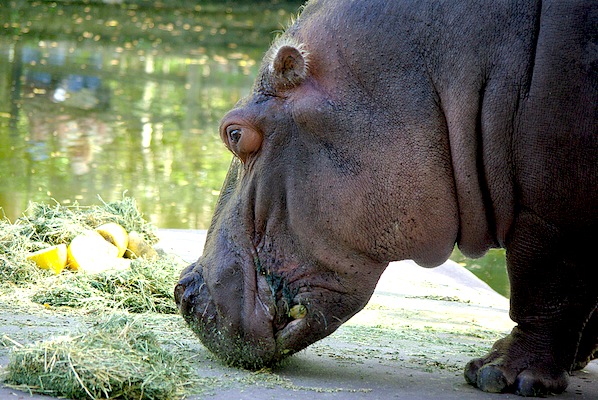
Turtle Hospital in Marathon
Like people, wild animals sometimes need a little help. This is especially true for sea turtles, who often get tangled up in fishing line, ingest marine debris or are injured by boats. When turtles are distressed, The Turtle Hospital in Marathon, Fla. comes to the rescue.
In 1993, a bar called Fanny’s was fully renovated and became what is now The Turtle Hospital. There’s a Turtle Ambulance parked outside and both an emergency room and operating room inside.
The Turtle Hospital is the only state-certified veterinary hospital in the world for sea turtles. More than half of the hospital’s equipment has been donated by hospitals, doctors, private individuals and organizations.
Daily tours are available. This educational experience lasts approximately 90 minutes and provides a presentation on sea turtles and a behind-the-scenes look at the hospital facilities and rehabilitation area. At the end of each program guests are invited to feed the permanent resident sea turtles. In the summer months the possibility of seeing sea turtle hatchlings adds to the excitement.
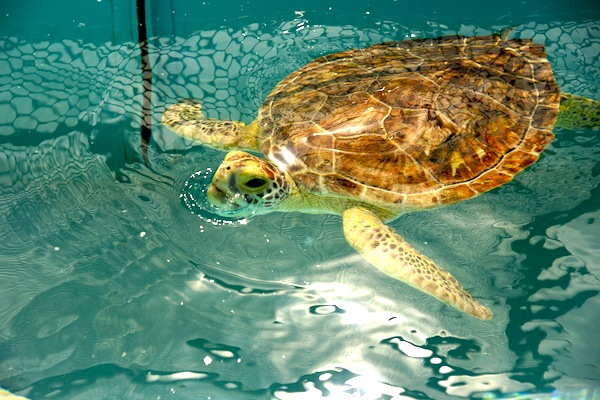
John Pennekamp Coral Reef State Park
Established in 1963, John Pennekamp Coral Reef State Park was the first undersea park in the U.S. Located on Key Largo, the park and the adjacent Florida Keys National Marine Sanctuary cover approximately 178 nautical square miles of coral reefs, seagrass beds and mangrove swamps.
The park extends three miles offshore. Traveling by boat to get there you’ll pass uninhabited mangrove islands, winding creeks and shallow reefs, all of which provide marine nurseries for the stunning, large coral-reef formations.
Explore the reef with a snorkel or scuba-diving tour or simply take a glass-bottom boat. Canoeing and kayaking on the mangrove-lined waterways are also favorite activities.
The visitor center features a refurbished 30,000-gallon aquarium. Canoe, kayak and boat rentals are available along with information on the numerous nature trails. If you want to commune with nature overnight, the park has 47 campsites, all with electrical hookups and running water.
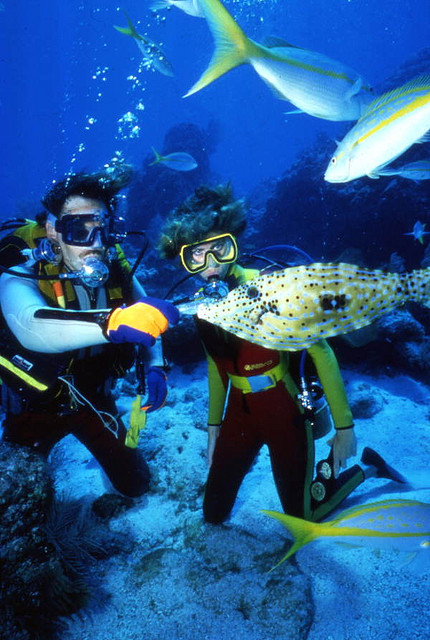
Westgate River Ranch
Long before cowboys became the symbol of the American West, Seminole Indians, Spanish colonists and American settlers called “Crackers” herded cattle in Florida. About an hour south of Orlando at the Westgate River Ranch –an authentic dude ranch— you can explore the lands roamed by America’s first cowboys and experience a Florida few tourists see.
The ranch occupies 1,700 acres surrounded by another 100,000 acres of state protected land, providing a beautiful, secluded location. Fish at the stocked Catch & Release fishing pond while keeping an eye on the Watusi cattle grazing in the pasture nearby. An on-site Petting Farm is home to friendly residents, including horses, ponies, mules, cows, goats, sheep, deer, turkeys, rabbits and pot-bellied pigs.
Take a rugged, one-hour ride on a swamp buggy through the ranch’s wooded trail and view wildlife in its natural setting. The Swamp Buggies come equipped with huge tires and can travel almost anywhere, making for an amazing journey through the brush. Explore the abundant wildlife on the Kissimmee River on an airboat ride where you may spot bald eagles, deer and alligators.
A Saturday Night Rodeo at the 1,200-seat rodeo arena draws cowboys from all over to compete in trick riding, barrel racing and, of course, bull riding. Little cowpokes can participate in a real “calf scramble” where boys and girls try to remove a ribbon from a calf’s tail. The first one to get the ribbon receives the prize.
